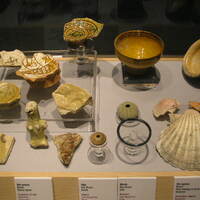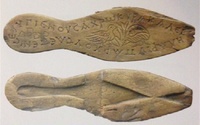Yenikapı excavations
Type:
Settlements
Date:
Fifth to eleventh centuries
Location or Findspot (Modern-Day Country):
Turkey
Medium:
Earthenware,
Bronze,
Lead,
Leather,
Wood
Description:
Since digging began in 2004 for the Marmaray Project—a subway under Istanbul and a tunnel linking the city's European and Asian halves—thousands of artifacts have been found. The site, in today's Yenikapı quarter, was revealed to be one of Constantinople's main ports, built by Emperor Theodosios I (r. 379–95) on the city's south side. The finds go back to the Neolithic age. The medieval artifacts date between the fifth and eleventh centuries; the harbor silted up by the twelfth century and the land was used for agriculture. The Harbor of Theodosios has proved to be a treasure trove of information about Byzantine economic activity and daily life.
In addition to an unprecedented array of animal and vegetal remains, the medieval finds from Yenikapı include at least thirty-seven shipwrecks, a church, and millions of artifacts in media that range from luxurious (gold, ivory) to mundane (wood, ceramic, leather). The ships revealed unprecedented information about Byzantine galleys and merchant ships, and the wooden finds (mostly oak) have altered dendrochronological datings of works around the eastern Mediterranean and the Black Sea. A wooden sole from a woman's shoe or sandal, likely dated between the fifth and seventh centuries, bears an image of birds and plants and a Greek inscription that reads, "Use [this] in good health, fair lady, be happy wearing [it]." It is not clear whether this was the sole of an actual shoe or a votive object.
A steelyard weight made of lead-filled bronze was used to counterbalance goods being weighed on the other side of a scale. An early Byzantine (sixth-seventh century) example from Yenikapı represented the goddess Athena (Roman Minerva), identifiable by the stylized Gorgon on her cloak. Early Byzantine weights often took the form of a goddess or empress, presumably to ensure customers that a fair transaction was under way. Athena weights tend to be larger and heavier than empresses. The Byzantines were proud of their Roman heritage and continued to depict classical figures throughout the centuries, even in explicitly Christian contexts.
In addition to an unprecedented array of animal and vegetal remains, the medieval finds from Yenikapı include at least thirty-seven shipwrecks, a church, and millions of artifacts in media that range from luxurious (gold, ivory) to mundane (wood, ceramic, leather). The ships revealed unprecedented information about Byzantine galleys and merchant ships, and the wooden finds (mostly oak) have altered dendrochronological datings of works around the eastern Mediterranean and the Black Sea. A wooden sole from a woman's shoe or sandal, likely dated between the fifth and seventh centuries, bears an image of birds and plants and a Greek inscription that reads, "Use [this] in good health, fair lady, be happy wearing [it]." It is not clear whether this was the sole of an actual shoe or a votive object.
A steelyard weight made of lead-filled bronze was used to counterbalance goods being weighed on the other side of a scale. An early Byzantine (sixth-seventh century) example from Yenikapı represented the goddess Athena (Roman Minerva), identifiable by the stylized Gorgon on her cloak. Early Byzantine weights often took the form of a goddess or empress, presumably to ensure customers that a fair transaction was under way. Athena weights tend to be larger and heavier than empresses. The Byzantines were proud of their Roman heritage and continued to depict classical figures throughout the centuries, even in explicitly Christian contexts.
Relevant Textbook Chapter(s):
2,
3,
4
Repository and Online Resources:
• Read about nautical archaeology on the Yenikapi Byzantine Shipwrecks Project website.
• Learn more about the shipwrecks from the Harbor of Theodosios here.
Image Credits:
Wikimedia Commons; Hurriyet Daily News





